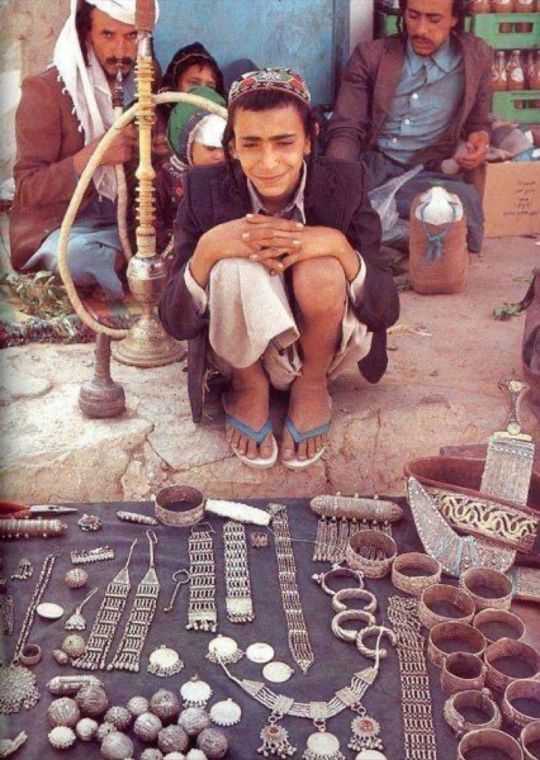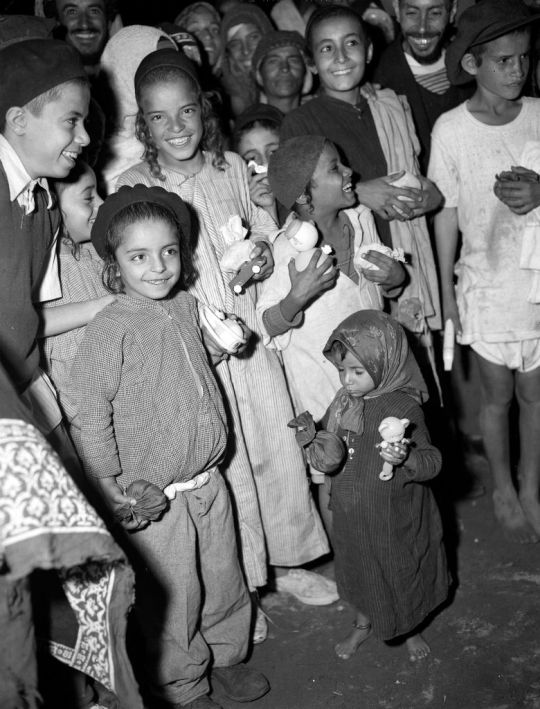#תימנים
Explore tagged Tumblr posts
Text








Handcrafted Yemenite silver filigree Mezuzot (png) by Chaim Gershon "Gershi" in Bnei Brak. x
Yemenite silversmithing is a historic craft practiced by the Jewish communities of Yemen. It is especially known for its filigree work, which produces intricate designs using fine silver wire. The results are ornate jewelry and other cultural and religious items. The traditional techniques are often passed down through generations.
Yemenite Jews have practiced silversmithing since at least the 1700s at a time when Muslims did not engage in this work, and their products were highly sought after in the southern Arabian Peninsula and beyond.
Following the mass exodus of Yemenite Jews in the mid-20th century, the majority fleeing to Israel, Yemenite silversmiths have continued practicing and passing down their craft. It remains a renowned aspect of Jewish artistic heritage.
#yemenite jews#yemeni jews#teimanim#temanim#mizrahim#mizrahi history#jewish history#jewish culture#jewish heritage#jewish art#mizrahi heritage#mirahi art#mena jews#swana jews#yemenite silversmithing#yemenite silversmiths#silversmithing#silversmith jewelry#judaica#mezuzot#mezuzah#judaism#jewish religious items#jewish diaspora#uploads#תימן#תימנים#judaica png#מזרחים#bnei brak
25 notes
·
View notes
Text
תימנים ארורים!!!!!!!!! 😡😡😡
5 notes
·
View notes
Text
למה הפסקנו לעשות ר כמו פעם. ולמה רק תימנים עושים ככה ע ו ח :(
5 notes
·
View notes
Text
אני סוג של שמחה שלא גדלתי עם סבא וסבתה או ההורים שלהם. הם היו תימנים ואמא שלי אומרת שהם מאוד הקפידו על עברית נכונה אפילו על דברים כמו ההבדל בין ע' וא'. אני פשוט לא חושבת שהייתי יכולה להתמודד עם משהו כזה.
Israelis
The only people in the world who can't speak their own language
Spoken hebrew obeys like 1 law out of 10 laws hebrew has
34 notes
·
View notes
Link
זה די מדהים שגל גדות היא אשכנזיה פר־אקסלנס מכל הצדדים, אבל איכשהו היא יצאה שחומה ומזרחית למראה. כאילו זה שהיא גדלה בראש העין עשה אותה תימניה באוסמוזה.
7 notes
·
View notes
Text
דליה, מה את עושה שאת בחופש?
כל הבוקר אני מנקה את בית, ועוזרת עם אחיינית שלי, ובודקת שהכלב שלנו לא החליט לשבת עליה, ואז הם הולכים, ואני אוכלת עוגיות ושותה תכוס השני של קפה, בלי לאכול כי אני כבר בראבק, ואז לא יודעת איך הגענו לזה, אבל אמא שלי שואלת על תימנים ולמה אובססיבים עם תהילים, אז פתאום כל המשפחה שלי רואים סרטון ואז סרט ביוטוב על תימנים והשירים שלהם, והריקוד, ואז אני עושה שיחת ווידאו עם הידיד שלי התמני להגיד לו שבא לי ללמוד את כל הריקודים, ואז אני נדבקת לגיטרה שלי, זוכרת לאכול ב18:00 בערב, וממשיכה ללמוד מוזיקה ופתאום וזה 2 לפנות בוקר ואני עדיין עם הגטרה, מנסה לסדר לעצמי טאבים ומילים לכל השירים בעולם. זה היום יומי פחות או יותר 😂😂
A side effect that no one tells about trying and hoping and wishing to be loved by people who are expected to, but just don't love you, is that gives you a wall. I don't know why, but I have a hard time loving people fully and loudly and unapologetically. Yet, the people who love me like this are my favorite people. No games, no nitpicking labels. I'm so used to people being confusing and nitpicking what I say, making it something I didn't mean, or a joke. I don't like that way of loving me. Where if I say boyfriend instead of boy friend they get uncomfortable. I want the never uncomfortable loving me.
I have trouble showering the people I love with love and showing love, because of a wall I have up. I have it since I didn't get all the love I wanted. That love that has pain. I need someone who really is ready to shower me with love I have an easy time feeling. The love that feels like sweet potato ravioli. It's warm and soft and comfortable and easy. No crunch no spice, just all warm and soft and creamy. I need to work on being about to shower people with love like the yeminite do.
My dear sweet dalya
You were five and you didn't realize anything with your family, but u felt it. You feel things like tension or discomfort energy in the air. You are very sensitive to that. You don't realize yet, but you will go through many years of many people who are supposed to love you- not loving you. And you might wonder what you did to deserve it, you might think you did something, you might just wonder why you feel different, you might feel lonely or angry or jealous or sad. Those are all normal emotions. Noone explained it to you, or validated the truth and reality so you could find comfort. You have to understand the truth, and then work on repairing the damage. So I'm talking to the five year old in you. As for the explanation I'm hugging you, I'm saying I'm sorry that this happened to you. I'm sitting down on the hardwood floor with you, holding your hands while I say this. Your family doesn't want anything to do with you. You are right with how you feel. But always know, this is a decision they chose, it has nothing to do with you. It says nothing about who you are, be it when ma didn't want you to come, when she didn't have the closest relationship with you, cheri, your cousins, pa, Daddys who family. It says everything about who they are, and nothing about who you are. It's a lot of pain, I get it. No one taught you how to love completely. And very few people in your life love you completely. But I love you. I will hug you as long as you need. I will give you sweet potato ravioli love because I know that pain. I'm not shying away from you or the pain. It socks. You wanted love from so many people and you didn't get it. But it doesn't need to affect you if you give love to yourself. Put down the war, cuz there's a five year old girl in you who needs an all incompassing womb warm soft love. I'm so sorry sweetie, I love you.
0 notes
Text
קוראים לך בשכונה
מלכת הגזענים
שונאת אתיופים, תימנים וערבים
רק עוד בחורה
בשדרות של תל אביב
הסתה את מעודדת כתחביב
12 notes
·
View notes
Text
תימנים כן, מנסיון רב
ישראלים יש לי שאלה חשובה
44 notes
·
View notes
Link
מהנדס תוכנה מצא את תמונת סבו, חוקר מצא תמונות של סבתו וצלם עם שם רוסי מצא קרובי משפחה תימנים. ארכיון יד בן צבי העלה לרשת מאות תמונות שצולמו במחנה חאשד ב-1949 לפני עלייתם לארץ http://ift.tt/2kwGD3V
0 notes
Text

A Jewish Yemeni boy pictured outside his home in Raydah, some 70 kilometers north of Sana'a on January 28, 2001.
The last remaining three Jewish families in Yemen were deported by Iranian-backed Houthi rebels in 2021, leaving only one Jewish man in the country that once held a diverse and ancient Jewish community. Levi Marhabi, held captive by the Houthis since 2016.
#teimanim#yemenite jews#yemeni jews#mizrahim#mizrahi jews#swana jews#mena jews#jewish diaspora#ישראבלר#��ימנים#yemen#yaman#mine#מזרחים#uploads
24 notes
·
View notes
Text

Yemenite silversmiths in the Bezalel School of Art (בצלאל pron. "Betzalel" after the biblical figure) in Jerusalem, 1909, courtesy of the Yemenite Jewish Heritage Center.
Silversmithing is a historic and renowned tradition among Yemenite Jews, often passed down through generations.
#bezalel#bezalel Academy#yemenite jews#yemeni jews#teimanim#jewish art#jewish culture#jewish historyjewish heritage#jerusalem#photography#uploads#mizrahim#mizrahi history#mizrahi jews#bezalel academy of arts and design#ירושלים#ישראל#ישראבלר#תימנים#בצלאל#yemenite silversmithing#yemenite silver#silversmithing#silversmith#eretz israel#ארץ ישראל
15 notes
·
View notes
Text

Handwoven Yemenite Jewish prayer shawl, Southern Yemen, Early 20th century. 275 x 102 cm. Gift of Yihya Ovadya Gibli, Jaffa.
"In Yemen, the biblical commandment (Num. 15:38–39; Deut. 22:12) to attach tassels (tzitzit) to the four corners of one’s garment is fulfilled by attaching tzitzit to the four-cornered outer garment worn daily; in other communities, where daily attire is not four-cornered, special ritual garments—the prayer shawl (tallit) and the vest-like tallit katan—have come to be used for this purpose.
The Jews of Yemen wore several types of four-cornered garments to fulfill the tzitzit precept. In Sana'a and on the Central Plateau, an everyday black woolen shawl worn over the shoulders served as a tallit. This type of shawl was an integral part of the Jewish male’s dress in the region, and the indicative offwhite ritual tassels hung from its four corners. A more precious version made of highly refined black wool was worn in this region on the Sabbath.
The garment’s Yemeni Arabic name shamleh recalls the Hebrew word simlah, used in the Bible. Both words carry the idea of a wrapped outer garment that envelops the wearer, as does the tallit when worn during prayers. As a four-cornered garment, the shamleh was subject to the commandment to bear tzitzit, and wearing it allowed one to fulfill the commandment with an article of clothing that served daily functions. In addition to being an article of clothing, it served as a blanket when resting, or a bag for bundling and carrying goods.
In rural Yemen, all men, Muslims and Jews, slung a striped, brightly colored cotton shoulder-cloth around their upper body called a lih feh or masnaf, edged with a woven band and fringes. On the four corners Jews added the ritual tassels, identifying themselves as Jews.
In southern Yemen, the tallitot were woven in color schemes of green, red, and yellow on an off-white background. These were the standard outer garment in this region, either rectangular in shape, or poncho-like with a hole or slit in the middle for the head, similar to the tallit katan (a small, four-cornered garment worn to enable one to fulfill the tzitzit commandment if one’s regular outer garment was not four-cornered). Silk squares were sewn on to reinforce the four corners where the tassels were fixed.
Skilled Jewish weavers made these garments. Among Yemeni Jews, weaving was a widely practiced and highly respected profession, one that was considered to require special skills. In the poncho-like tallit, the edges around the head and neck opening were embroidered with stitches typical of the area. At the turn of the twentieth century, the Ashkenazi white rectangular tallit with its blue or black stripes along the shorter, fringed hems, called shal in Yemen, frequently replaced the traditional Yemenite prayer shawls." x
#tallit#judaica#teimanim#yemenite jews#yemeni jews#mizrahi jews#textile art#jewish heritage#tzitzit#תימנים#מזרחים
15 notes
·
View notes
Text

A Yemenite Jewish man looks after his grandchild in a refugee camp in Israel, 1949. Boris Carmi (1914 - 2002).
Since the Houthi rebels forcibly deported the last three Jewish families from Yemen in 2021, only one Jew is known to remain in a country that once held an ancient and diverse Jewish population. Levi Marhabi, held captive by the Houthis since 2016.
#yemenite jews#yemeni jews#teimanim#תימנים#ישראבלר#ישראל#mizrahi jews#israel#mizrahi#teiman#photography#swana Jews#Mena Jews#uploads#mizrahi history#mizrahim
14 notes
·
View notes
Text

A young Yemenite Jewish silversmith sells the handcrafted goods of his family business, including beads, necklaces, earrings, bangles, amulets and a jambiya or men's dagger including an ornate sheath with the accompanying belt. Though the ornamental scabbard sheaths were often crafted by Jewish silversmiths, only Arabs in Yemen were permitted to wear these daggers. In the background Jewish men are seen smoking shisha tobacco and possibly chewing Khat with little girls around. Yemen, 1980s. Only one Jew is known to remain in Yemen today.
#he looks so adorable#yemenite jews#teimanim#yemenite silversmithing#yemenite silversmith#silversmithing#temanim#yemeni jews#mizrahim#nargilah#jewish art#jewish heritage#תימנים#מזרחים#khat
18 notes
·
View notes
Text

Jewish women applying henna in Barat, northern Yemen, 1984. The Hebrew word כפר kopher is used several times in Shir haShirim / the Song of Songs, where it is generally accepted to refer to the henna plant. x x
אֶשְׁכֹּ֨ל הַכֹּ֤פֶר ׀ דּוֹדִי֙ לִ֔י בְּכַרְמֵ֖י עֵ֥ין גֶּֽדִי׃ {ס}
My beloved to me is a spray of henna blooms
From the vineyards of En-gedi.
x
#henna#jewish heritage#jewish culture#teimanim#mizrahi jews#yemenite jews#yemeni jews#photography#kopher#shir hashirim#song of songs#uploads#mizrahim#מזרחים#תימנים#חינה#Jewish wedding#judaism#ein gedi#עין גדי#שיר השירים
12 notes
·
View notes
Text

Yemenite Jewish children and their toys in the Hashed camp near Aden, Yemen in 1949. Most likely awaiting airlift to Israel as part of Operation magic carpet which sought to save Yemenite Jews from their increasingly hostile countrymen.
Only one Jewish man is known to remain in Yemen today, Levi Marhabi, held captive by the Iranian-backed Houthi rebels since 2016.
#yemenite jews#teimanim#yemeni jews#mizrahim#mizrahi jews#swana jews#mena jews#operation magic carpet#israel#yemen#ישראבלר#ישראל#תימנים#uploads
11 notes
·
View notes